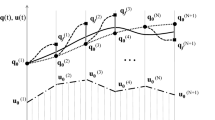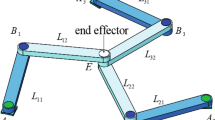Abstract
The present approach aims at using the principle of redundant actuation for parallel robotic structures in order to follow complex trajectories in a so-called “mechanically advantageous” way, meaning that for any trajectory configuration the actuators can bear important loads (internal and/or external). Multibody system formalisms using relative coordinates and a robust technique to solve the closed-loop kinematic constraints, which are used for the purpose of modeling, are briefly reviewed. The notion of robot manipulability (and its relation to the velocity and force ellipsoids) is then recalled. As an initial step of the approach developed, suitable locations for the actuators of the non-overactuated system are proposed, the criteria being based on the theoretical concepts mentioned above. Then, according to some possible “customer” requirements, the number of actuators and their location are optimally specified on the basis of a piecewise trajectory planning. Both static and dynamic aspects are treated, depending on the application. Once the number and the locations of the actuators have been determined, a solution for the overdetermined inverse dynamics is proposed. Finally, the approach is validated via two examples of multibody parallel structures that are modeled, simulated and controlled in a suitable environment.
Similar content being viewed by others
References
Walker, I.D., Freeman, R. and Markus, S. Analysis of motion and internal loading of objects grasped by multiple cooperating manipulators. International Journal of Robotics Research 10(4), 1991, 396–409.
Kumar, V. and Waldron, K. Force distribution in walking vehicles. ASME Journal of Mechanical Design 112(1), 1990, 90–99.
Klein, C. and T. Chung ‘Force interaction and allocation for the legs of a walking machine’ IEEE Transactions on Robotics and Automation, 3, 1987, 546–555
Gonzales, L. and Sreenivasan, S. Representational singularities in the torque optimization problem of an active closed-loop mechanism. Mechanism and Machine Theory 35, 2000, 871–886.
Dasgupta, B. and Mruthyunjaya, T. Force redundancy in parallel manipulators: theoretical and practical issues. Mechanism and Machine Theory 33(6), 1998, 727–742.
Ganovski, L., Fisette, P. and Samin, J.C. Modeling of overactuated closed-loop mechanisms with singularities: simulation and control, ASME DETC AND Computers and Information in Engineering Conference, Pittsburgh, Pennsylvania, USA, 2001.
Choudhury, P. and Chosal, A. Singularity and controllability analysis of parallel manipulators and closed-loop mechanisms. Mechanism and Machine Theory 35, 2000, 1455–1479.
Merlet, J.P. Parallel Robots. Kluwer Academic, Dordrecht, 2000.
Wen, J.T.-Y. and L. Wiltinger Kinematic manipulability of general constrained rigid multibody systems, IEEE International Conference on Robotics and Automation, 1999, 558–567.
Yoshikawa, T. Manipulability of robotic mechanisms. International Journal of Robotics Research 4(2), 1985, 3–9.
Fisette, P. and Samin, J.C. Symbolic generation of large multibody system dynamic equations using a new semi-explicit Newton/Euler recursive scheme. Archive of Applied Mechanics 66, 1996, 187–199.
Luh, J.Y.S., Walker, N.W. and Paul, R.P.C. On-line computational scheme for mechanical manipulators. Journal of Dynamics Systems, Measurements and Control 102, 1980, 69–76.
Fisette, P., Samin, J.C. and Willems, P.Y. Contribution to symbolic analysis of deformable multibody systems. International Journal of Numerical Methods in Engineering 8, 1991, 1621–1635.
Fisette, P., Lipinski, K. and Samin, J.C. Symbolic modelling for the simulation, control and optimization of multibody systems, in A. Kecskem’ethy (ed.), Advances in Multibody Systems and Mechatronics, Graz, 1999, 139–174.
Wehage, R.-A. and Haug, E.-J. Generalized coordinate partitioning for dimension reduction in analysis of constrained dynamic systems. Journal of Mechanical Design 134, 1982, 247–255.
Fisette, P. and Samin, J.C. Robotran symbolic generation of multibody system dynamic equations, W. Schiehlen (ed.), Advanced Multibody System Dynamics: Simulation and Software Tools, Dordrecht, the Netherlands, 1993, 373–378.
Fisette, P. and Samin, J.C. The modelling of complex mechanical systems in the MATLAB/SIMULINK Environment, First Benelux MATLAB Usersconference, Amsterdam, 1997, 1–11.
Author information
Authors and Affiliations
Corresponding author
Rights and permissions
About this article
Cite this article
Ganovski, L., Fisette, P. & Samin, J.C. Piecewise Overactuation of Parallel Mechanisms Following Singular Trajectories: Modeling, Simulation and Control. Multibody Syst Dyn 12, 317–343 (2004). https://doi.org/10.1007/s11044-004-2532-1
Received:
Accepted:
Issue Date:
DOI: https://doi.org/10.1007/s11044-004-2532-1




